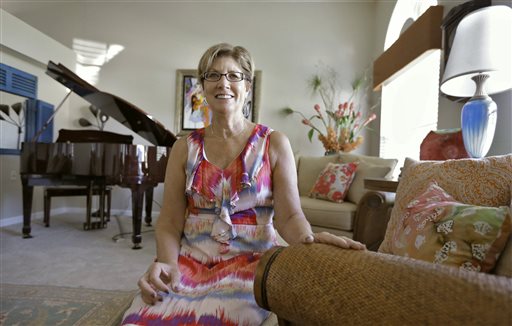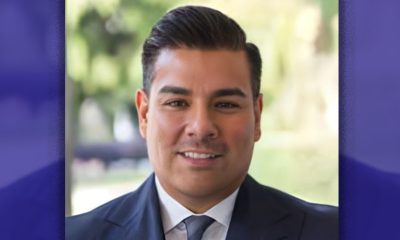Business
Boomerang Home Buyers Poised to Return to Market with a Roar


In this Aug. 10, 2015 photo, Debbie Cooley-Guy sits in the living room of her new home in New Port Richey, Fla. (AP Photo/Chris O’Meara)
TAMARA LUSH, Associated Press
TRINITY, Fla. (AP) — Tears still spring into Debbie Cooley-Guy’s eyes when she thinks about her dream home, with its wide, sweeping porch. It overlooked a bayou filled with wading birds, a glittering blue pool and the space for not only a 12-foot Christmas tree, but a grand piano as well.
She bought the home in a suburb west of Tampa for $637,000 in 2002. Seven years later, after the economy tanked, she sold it for less than she owed on her mortgage to avoid foreclosure. She recalls the black moment when she was still caring for the lawn but not living there. A falling branch knocked down an outdoor staircase railing.
“It made the house look so sad. I was so sad,” said Cooley-Guy, 60. “I drove away crying. I just didn’t think it was how the story would end with this house.”
On that dark January day, Cooley-Guy thought her home owning days were over.
Just a few years later, she’s back in a new, smaller home, one of America’s growing ranks of “boomerang buyers.”
Seven years after the real estate bust, many who lost their homes have rebuilt their credit and are back in the market. Experts say these boomerang buyers will be an important segment of the real estate market in the coming years.
About 700,000 of the 7.3 million homeowners who went through foreclosure or short sales like Cooley-Guys’ during the bust have the potential to get a mortgage again this year, said Daren Blomquist, vice president of Realty Trac. That compares to the 3 million people overall who got a mortgage between October 2013 and September 2014.
A recent increase in loans from the Federal Housing Authority also shows first time homebuyers and boomerang buyers are helping drive the market, Blomquist said.
It generally takes seven years for a foreclosure to drop off a credit report. Short sales take less time, generally three or four years.
Greg McBride, a chief financial analyst at bankrate.com, said it’s difficult to tell if boomerang buyers are affecting the market — at least this year.
“The prices are rising because of the limited inventory,” he said. “Boomerang buyers are part of the demand but not a huge component.”
In the coming years, though, as foreclosures continue to drop off credit reports, more people will get back in the market, analysts said. A Realty Trac report earlier this year predicts Phoenix and Miami will see the most boomerang buyers. The Tampa area is in the top 10 cities. In some markets, such as Las Vegas, as many as quarter of homes could be bought by boomerang buyers, Realty Trac predicts.
John Councilman, president of the Association of Mortgage Professionals, said a wide swath of people with past credit problems are seeking mortgages, not only foreclosures or short sales. “We have a lot of people with issues and many are coming back into the market.”
That describes Cooley-Guy. As a mortgage loan originator herself, she should have known the pitfalls, but she said she was caught up in the boom, in the possibility of living in her dream.
“I used to look at people like me and think, ‘How did you let this happen?'” she said. “In hindsight, I had set myself up so well. Just because you can afford things, it doesn’t mean you should buy them.”
The boom was good to her. By 2002, she was making $250,000 a year and her husband made another $150,000. She had two vacation homes, $100,000 in a retirement account and $60,000 in cash savings.
She qualified for a mortgage for the 3,500-square-foot Key West style home with just her income. During the closing, she handed over a $120,000 check.
In hindsight, there were signs that her business, and the entire Florida real estate industry, were built on quicksand. Poorly paid waitresses were getting loans for investment properties. Realtors were buying six pre-construction properties at once. People were buying million-dollar homes, just to flip for a profit.
“I bought into the whole thing that my customers did,” she said.
In October 2005, she first noticed something was wrong.
“There was a real silence in the real estate office,” she recalled. “The Realtors were like, ‘What’s going on? This is quiet.’ I got nervous.”
But in 2006, Cooley-Guy took the biggest risk of all: she started her own loan origination company, taking out a $100,000 line of credit against her dream home, which had been reappraised at $1.2 million.
In 2008, her income dipped to $150,000. The next year she made $38,000. Her husband’s trucking company folded. They cashed in the retirement fund, spent the savings and started living off credit cards.
Cooley-Guy agreed to a short sale for $598,000, which covered her first mortgage. The bank forgave all but $40,000 of her $100,000 second mortgage, but she’s still making payments.
She and her husband rented a home. She slowly started paying bills, settling with credit card companies until she had absolved her $60,000 debt.
As the economy improved, so did Cooley-Guy’s income. She underwrote loans and soon nearly half her business was with people back after past problems with mortgages.
People like her.
Cooley-Guy had socked away some money and was yearning to buy again. This time, she and her husband found a $225,000, three-bedroom, two-bath in Pasco County, some 20 miles inland from her dream home. Because she had repaired her credit, she qualified for an FHA loan and in April 2014, bought again.
The 2,000-square-foot home with mint green trim is smaller than her old house. But there are high ceilings, space for her Mexican and Indonesian-themed art, a small pool. The back patio overlooks a canal with wading birds.
But the home represents more than stucco and beams. The whole ordeal — of buying, then losing her dream home, then boomeranging back into a new home — changed Cooley-Guy.
“I’ve learned to be so much of a better listener,” she said. When prospective clients come in with records of foreclosures and short sales, she empathizes. She tells them her story and encourages them.
A new beginning is possible, she tells them.
___
Follow Tamara Lush on Twitter at http://twitter.com/tamaralush.
Copyright 2015 The Associated Press. All rights reserved. This material may not be published, broadcast, rewritten or redistributed.











































